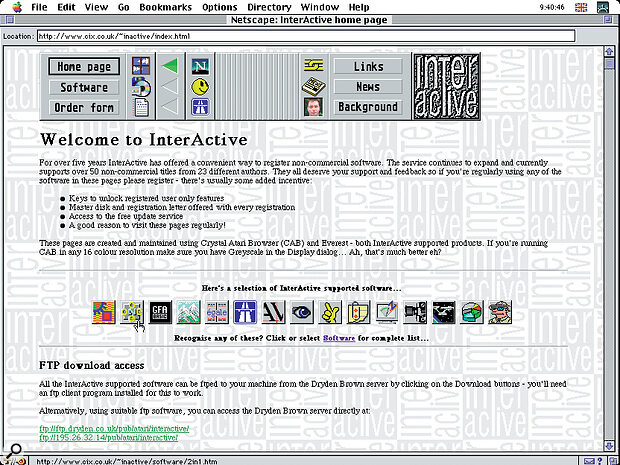 Joe Connor's InterActive shareware support web site makes it easy to get hold of and register a wide range of ST shareware.
Joe Connor's InterActive shareware support web site makes it easy to get hold of and register a wide range of ST shareware.
Hardware development is still going on for Atari computers: now STe users can buy a new processor accelerator that brings faster operation and an internal hard drive to STe computers, for relatively modest cost. Derek Johnson feels the need for speed...
There are many things you can do to improve the speed and performance of your ST: use an alternative OS, install an alternative desktop, buy a hard drive. You'll certainly notice a difference. But there's nothing like actually giving your computer's now‑aged processor a kick up the pants, and that's exactly what the new Veloce+, from The Upgrade Shop, offers. This STe‑specific accelerator has been developed especially for people who use Steinberg's Cubase v3 or Cubase Score, or Emagic's Notator Logic on their STs; other high‑end software, such as graphics and DTP packages, will also benefit. If you're feeling frustrated at performance bottlenecks and sluggish boot‑ups, Veloce+ could be the extra for you.
The new board fits inside your STe's case, mounted on top of the computer's main processor, along with an optional IDEal hard drive system. The accelerator uses a 32‑bit 68020 microprocessor, clocked at 16mhz, with the excellent TOS2.06 operating system and 2Mb or 4Mb of 32‑bit fast RAM fitted. The fast RAM utilises the full potential of the 68020 to give the system its real speed. The Veloce+ RAM adds one interesting side‑effect: it's added to whatever you have installed in your STe. So if you have a 4Mb machine, say, adding the accelerator will increase your RAM allocation to 6Mb or 8Mb. In the rare cases where a piece of software can't see all that RAM, the original 4Mb should still be visible, and if you're running software that's incompatible with TOS2.06 you can also switch back to the original STe processor.
Pricing depends on what you buy; the Veloce+2, with 2Mb fast RAM fitted costs £149, while the Veloce+4, with 4Mb fast RAM, will set you back £189. An internal hard drive — a miniature model is used — can also be added, starting at £100 for 170Mb and going up to £160 for 720Mb. The systems can be supplied for DIY installation, or there's a fitting service costing £15, plus £7 courier collection and delivery in each direction.
If you don't have an STe and would like to take advantage of all this internally‑mounted power, perhaps now is the time to upgrade your machine. It's still possible, in local 'Free Ads'‑type papers, to find Ataris of all flavours for between £40 and £100 without a monitor. In fact, just as I was finishing this I found a 1Mb 520STe for exactly £40 in my area.
Expanding Options
As you may know, there's a lot of software on the Internet — much of the public domain and shareware material I discuss in this column is obtainable in this way, as well as from postal libraries. When software is distributed electronically, it's invariably been data‑compressed in some way. This saves space wherever the software is being stored, and it takes less time to download, which saves you money on your phone bill, though you do need to decompress the software before you can use it. Luckily, there's a large number of tools out there for handling the different compression formats.
The majority of software I've been downloading on your behalf lately has been in ZIP format. The ideal tool for extracting files from ZIP archives is STZip, by Vincent Pomey; this is 'postcard ware' (just send Vincent a postcard!), so you have absolutely no excuse for not registering. You can find it in most PD libraries, or download it from the ever‑reliable Ultimate TOS Software Index ( ping4.ping.be/dipching‑drulkhor/PRG‑IND2.HTM).
Lately, I've also come across a couple of software archives with an LZsuffix. I do have tools to deal with this kind of archive, but they're based on a tedious command‑line interface (CLI). So I had a look on the Internet for a shell program — something to provide a graphic front end to CLI software. I found it in Gregor Duchalski's Two‑in‑One shareware archive manager. Two‑in‑One provides a comfortable GEM interface for packing and unpacking all the popular archive formats, including ZIP, LZH, ARC, ARJ and ZOO. You don't really need to know what the various formats are, except inasmuch as you'll need the archiving tools themselves — Two‑in‑One merely provides the shell to software you may already have. However, registering your Two‑in‑One will provide you with the latest version of the program, a personalised key, and copies of all the archive utilities used by the program. Other utilities and file viewers can be integrated into Two‑in‑One, creating an easy‑to‑use setup capable of packing and unpacking any archive format, creating and decoding uu‑encoded archives, scanning for viruses, copying, moving and deleting files, and viewing any file from any archive without having to extract the complete archive. On‑line help is provided by the ubiquitous ST‑Guide accessory.
<!‑‑image‑>Registering Two‑in‑One couldn't be easier. Although the software is German, it's been translated into English and is registerable via the InterActive web site, run by Joe Connor, who you may know as editor of Atari Computing, the sole UK‑based print mag for ST users. InterActive (www.cix.co.uk/~inactive/index.html) offers a convenient way to register non‑commercial software, with support for over 50 titles by 23 authors. The site is also a good place to download the latest versions of the support software. Two‑in‑One costs just £13 to register.
